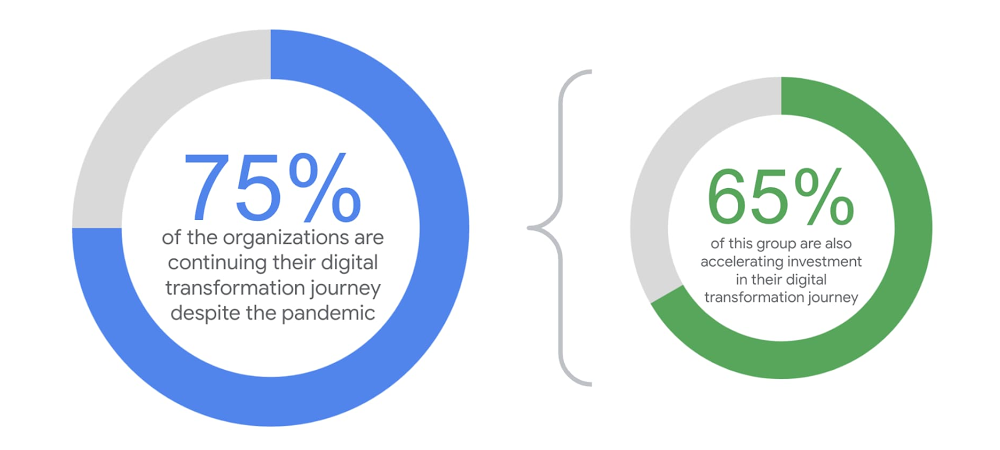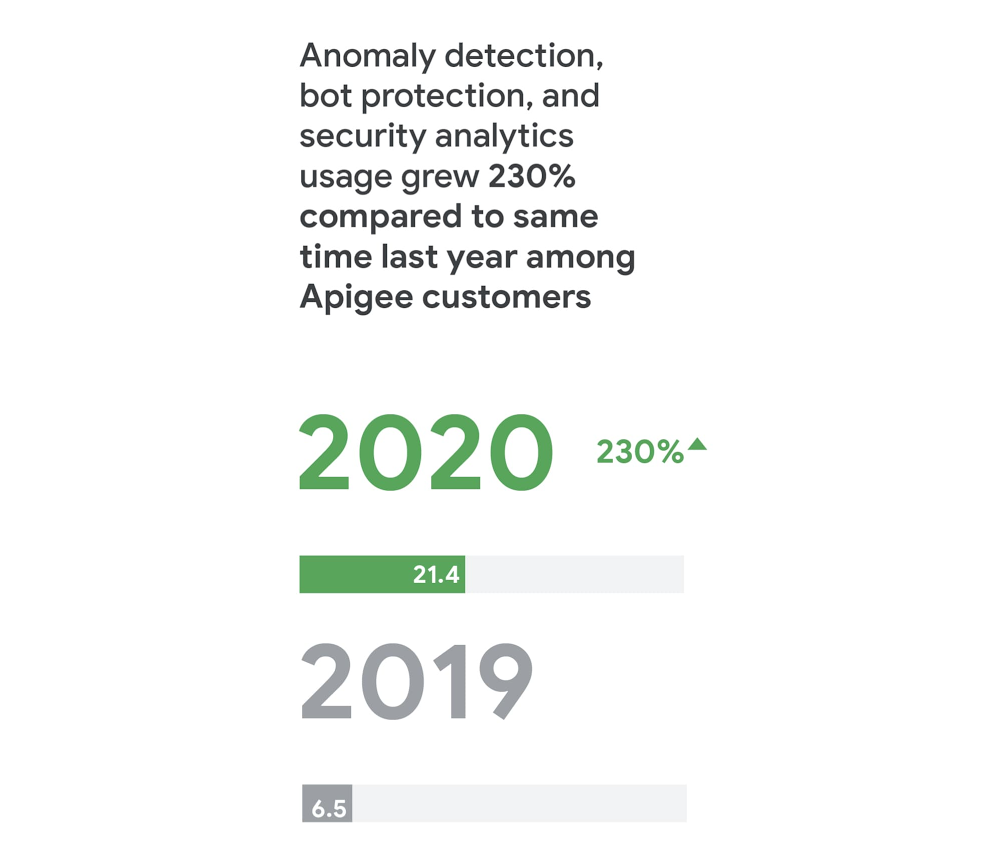GCP – Top 5 trends for API-powered digital transformation in 2021
Our “State of the API Economy 2021” report confirms that though digital transformation has been among enterprises’ top business imperatives for years, the COVID-19 pandemic and changing market conditions have increased this urgency. Organizations across the world weathered the pandemic by compressing years of digital transformation into just a few months.
Our research reflects this urgency: in response to the pandemic and its rippling effect on business in 2020, nearly three in four organizations continued their digital transformation investments. Two-thirds of those companies are increasing investments or completely evolving their strategies to become digital-first companies.

Digital transformation relies on an organization’s ability to package its services, competencies, and assets into modular pieces of software that can be repeatedly leveraged. Every company in the world already has valuable data and functionality housed within its systems. Capitalizing on this value, however, means liberating it from silos and making it interoperable and reusable in different contexts—including by combining it with valuable assets from partners and other third parties.
APIs enable these synergies by letting developers easily access and combine digital assets in different systems, even if those systems were never intended to interoperate. In their most basic form, APIs are how software talks to software, but if the APIs are designed with the developer experience in mind, rather than just as bespoke integration projects, they become extremely powerful, enabling developers to repeatedly leverage data and functionality for new apps and automations.
As part of creating the “State of API Economy 2021” research report, we surveyed over 700 IT executives around the globe to identify key trends about how they are responding to the pandemic and its rippling effects on business. Our findings identified five key trends in 2021 for API-first digital transformation:
1. Increasing SaaS and Hybrid Cloud-based API Deployments
When asked about future areas of technology focus and investment, one in two respondents reported increasing SaaS use to administer workloads, as well as an increase in hybrid cloud adoption —both areas in which APIs are crucial tools.
APIs serve a variety of use cases from connecting internal applications to enabling digital ecosystem strategies, so it’s no surprise that many organizations are choosing to leverage a mix of on-premises and cloud infrastructure to host those APIs.
2. Analytics Expand Competitive Advantage
While deploying APIs helps companies develop their digital presence, measuring API performance is key to optimizing their use and illuminating further routes to innovation.
When our survey respondents were asked how APIs at the company are currently measured, top responses included metrics focused on API performance, those focused on traditional IT-centric numbers, and those focused on consumption of APIs. But when asked about preference for API measurement, business impact—including Net Promoter Score (NPS) and speed-to-market—tops the list.
Leading businesses use API analytics to not only inform new strategies but also align leadership goals and outcomes. Because executive sponsors tend to support tangible results (like an API that’s attracting substantial developer attention or accelerating delivery of new products), teams can use API metrics to effectively unite leaders around digital strategies and justify continued platform-level funding for the API program.
3. AI and ML – Powered API Management is Gaining Traction
While some aspects of API security and management are as straightforward as applying authentication mechanisms to control access or applying rate limits when API calls exceed a certain limit (such as during a DDoS attack), artificial intelligence (AI) and machine learning (ML) are emerging as important ways for organizations to bolster their API management and security capabilities.
It’s no wonder that new, AI- and ML-powered API security and monitoring solutions are gaining widespread adoption to help companies detect and block malicious attacks. In fact, usage for anomaly detection, bot protection, and security analytics grew 230% year-over-year among Apigee customers between September 2019 and September 2020.

4. API Ecosystems Are Innovation Drivers
APIs are the backbone of digital business ecosystems that encompass networks of partners, developers, and customers. These ecosystems may be composed entirely of internal parties (i.e., developers within an organization) or may include external individuals and organizations, such as suppliers, third-party providers, contractors, customers, developers, regulators, or even competitors.
Our research found that while companies of all API maturity levels are likely to be focused on speeding up development of new applications and connecting internal applications, high-maturity organizations are significantly more likely to focus on developing a developer ecosystem or B2B partner ecosystem around their APIs.
5. API Security and Governance More Important Than Ever
In 2020, virtually all industries, from retail and manufacturing to finance and hospitality, shifted how they do business, with a focus on digital maturity coming into sharp relief in the wake of COVID-19. Customer, employee, and partner-facing operations all moved to digital mediums. While this created new opportunities for innovation, it also exacerbated the difficulty of keeping up with growing security threats by opening up more avenues for hackers to access sensitive data.
When designed and managed properly, APIs provide business optionality to control access to digital assets, to combine old systems with new technologies, and to empower developers to experiment, innovate, and react to changing customer needs. But APIs exposed without the proper controls, security protections, developer considerations, and visibility mechanisms can become a liability that puts corporate and customer data at risk.
Our research demonstrates increased investment in security and governance remain top-of-mind to enable enterprises better leverage and protect their digital assets.
Even as 2021 begins with carryover from many of 2020’s challenges, looking ahead, enterprises should start thinking beyond digital transformation for the coming decade and strive to achieve digital excellence. Businesses will need to leverage advanced cloud capabilities around security, global reach, access management, and artificial intelligence to support the growing global digital ecosystems. With well-designed and managed APIs, enterprises can help ensure that they’re able to adapt their business from one disruption to the next. And, at Google, we are here to partner with you to help achieve your digital excellence.
Want to learn more?
The “State of API Economy 2021” report describes how digital transformation initiatives evolved throughout 2020, as well as where they’re headed in the years to come. This report is based on Google Cloud’s Apigee API Management Platform usage data, Apigee customer case studies, and analysis of several third-party surveys conducted with technology leaders from enterprises with 1,500 or more employees, across the United States, United Kingdom, Germany, France, South Korea, Indonesia, Australia, and New Zealand.
Read More for the details.


